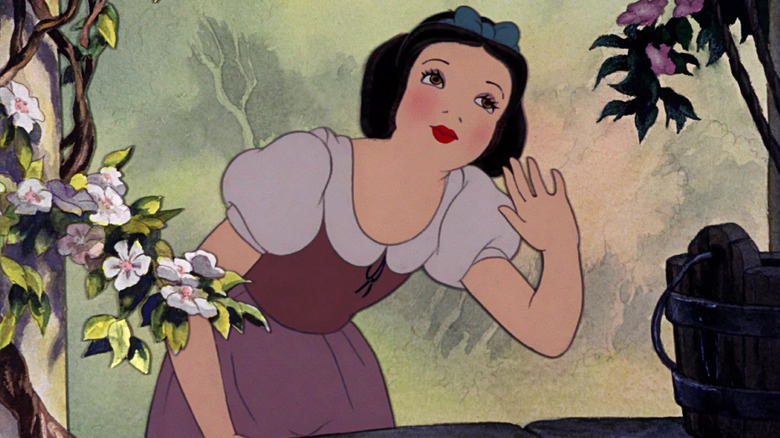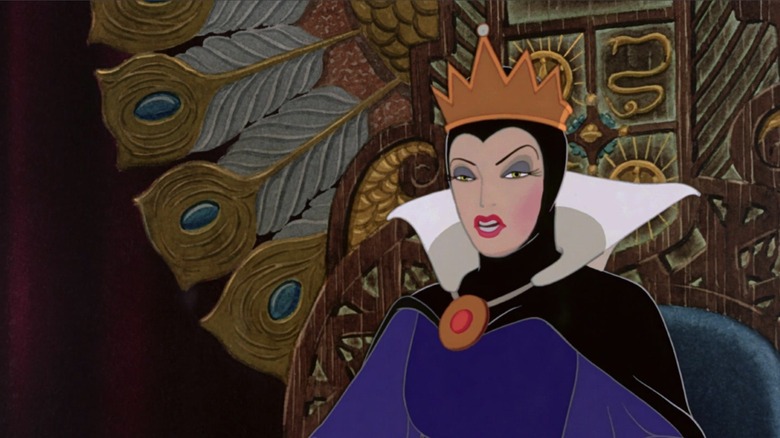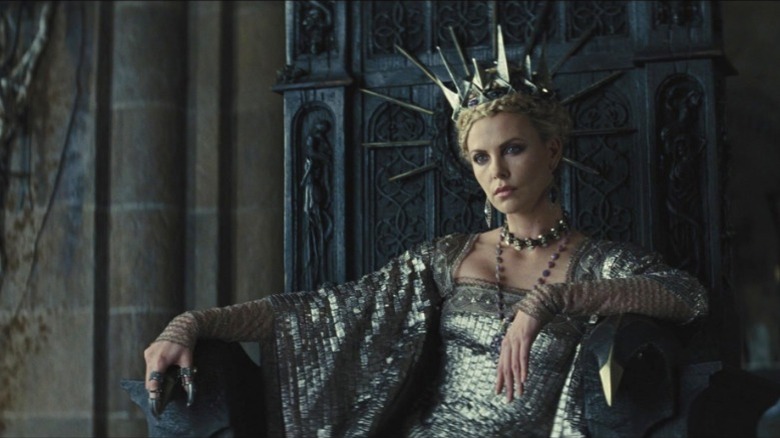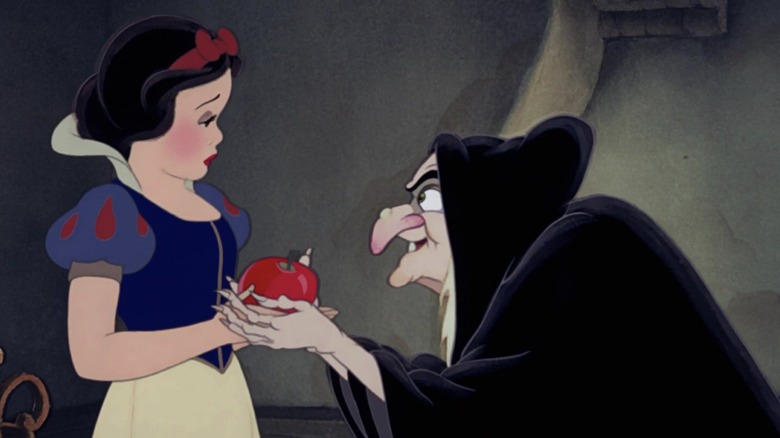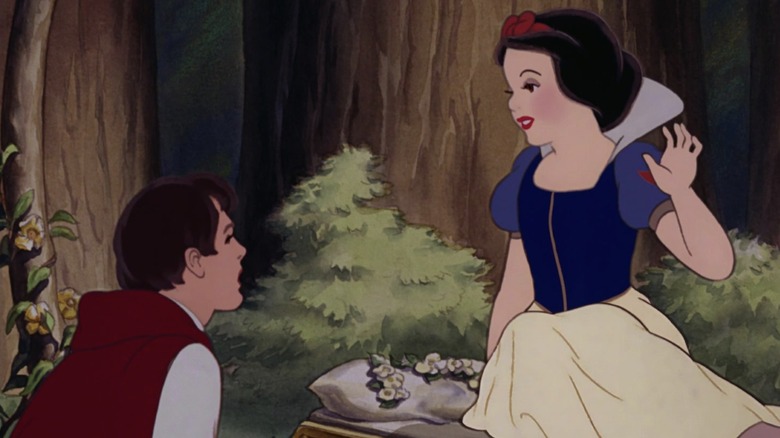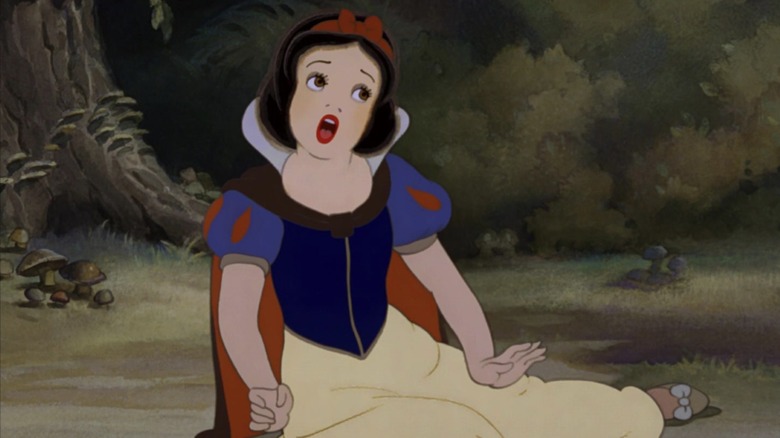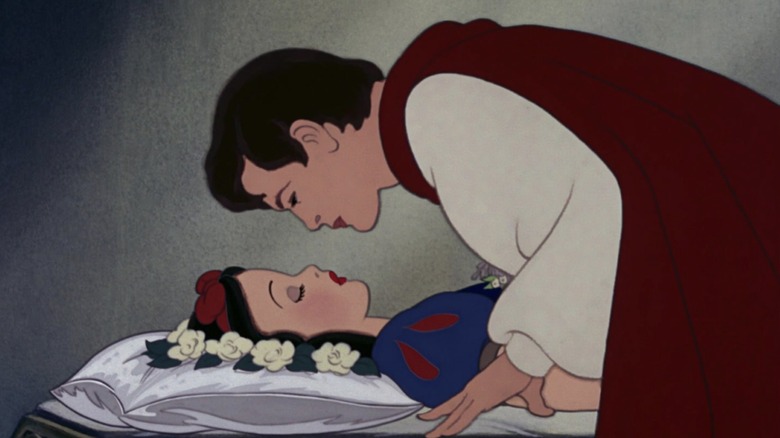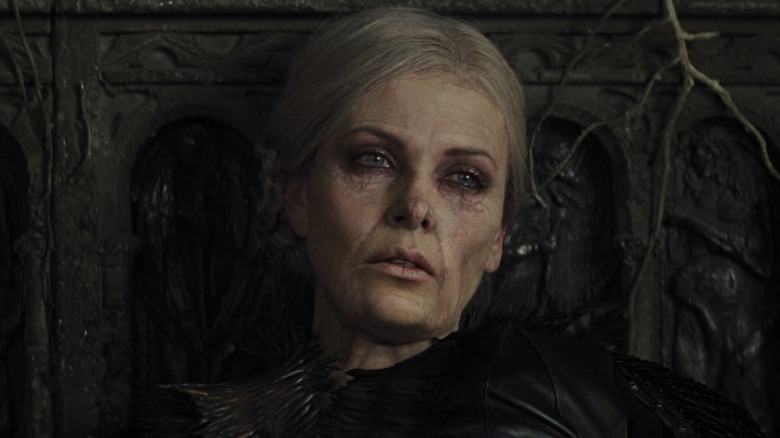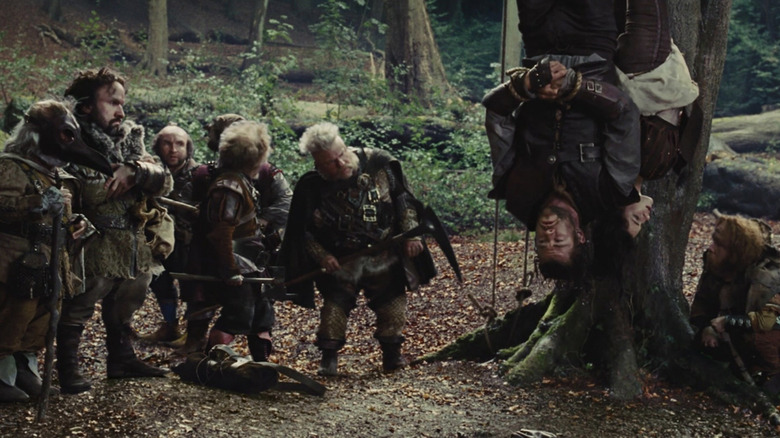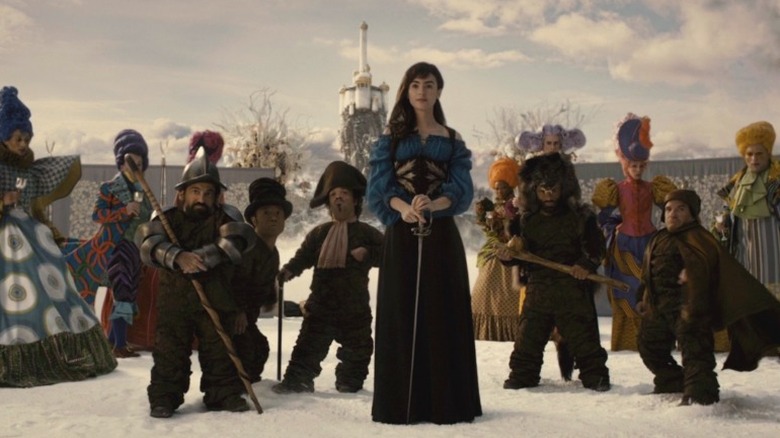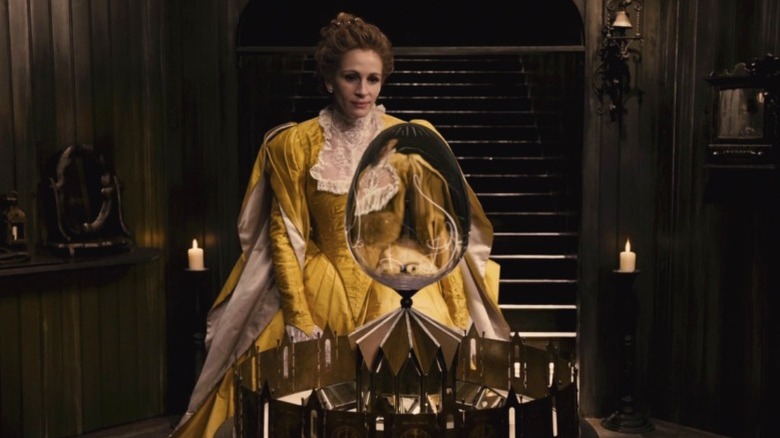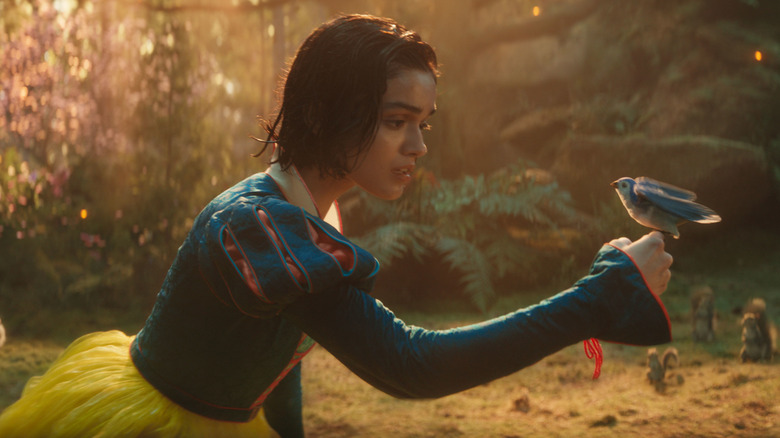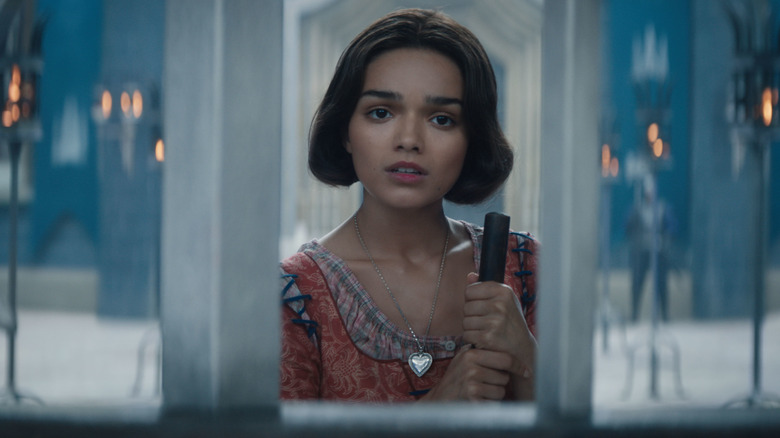The Dark History Of Snow White
Disney's animated classic "Snow White and the Seven Dwarfs" not only saved Disney Studios, but helped grow the company into the entertainment giant it is today. Its first animated feature film changed how audiences thought about the medium. From then on, we would regard animation as a legitimate art form, suitable for telling stories the whole family would enjoy. This animated masterpiece also began sanitizing once gruesome fairy tales into family-friendly entertainment. Disney would continue this endeavor throughout the 20th century as it transformed multiple fairy tales into commercially successful animated classics.
In her book "The Hard Facts of the Grimms' Fairy Tales," professor and scholar Maria Tatar suggests Disney finished the work the Brothers Grimm began in 1812 when they published their first compilation of fairy tales. She wrote, "Wilhelm Grimm rewrote the tales so extensively and went so far in the direction of eliminating off-color episodes that he can be credited with sanitizing folktales." The Brothers Grimm revised their fairy tale collection 17 times between 1812 and 1864, and "Snow White" experienced some important changes during that time.
Despite Wilhelm Grimm's efforts to tone down and tame some of the darker elements in the European folktales, the Brothers Grimm versions were still far more violent, disturbing, and adult than the versions Disney popularized. In the last decade, we have seen many new films returning to the macabre, twisted, and dark origins of these fairy tales. Join us as we explore the dark history of Snow White.
The Grimm version began with a wish for a child
The 1819 Grimm version of the story begins like many fairy tales, with a queen wishing for a daughter. After pricking her finger while sewing, three drops of blood land on the snow, and the queen is struck by the beautiful contrast, thinking, "If only I had a child as white as snow, as red as blood, and as black as the wood in this frame." Soon after, the queen is blessed with the birth of a daughter, but the queen dies during childbirth.
Within a year, the king remarried "a beautiful woman, but she was proud and arrogant" (per Grimm). The new queen worries someone will eclipse her beauty, so she asks her magic mirror if she is still the most beautiful. All is well until Snow White becomes more beautiful, and then there is hell to pay. In this version of the Grimm story, the king is never mentioned again, leaving us to wonder if he also died, or if he allows his new wife to mistreat Snow White.
Disney's version skips Snow White's origins, setting the stage by telling us Snow White lives with her "Wicked Stepmother" who dresses Snow White in rags and makes her work as a "scullery maid." There is no mention of Snow White's parents in the Disney classic, leading audience members to assume both parents were dead. It's been suggested they streamlined the story because of the constraint of an 88-minute running time.
The Evil Queen eats the internal organs
In the Disney animated classic, the Evil Queen asks the Huntsman to take Snow White into the woods to kill her. The queen is a distrustful person, and tells the Huntsman to bring her Snow White's heart as proof the girl is dead. Of course, the Huntsman can't bring himself to kill the beautiful child, and allows her to run away into the woods. He then kills a wild boar and takes its heart to the queen.
In some Brothers Grimm versions of the fairy tale, it is Snow White's liver and lungs that the Queen requests, while in other early versions it is her heart she asks the Huntsman to bring back. The gruesome detail Disney left out of the story is the wicked Queen cooks and eats the organs the Huntsman brings to her. "The cook had to boil them with salt," one Grimm version reads, "and the wicked woman ate them, supposing that she had eaten Snow-White's lungs and liver."
Cannibalism certainly is dark and twisted. Disney would never explore such depraved themes, but this macabre element of the story was explored in "Snow White and the Huntsman," when the magic mirror tells Queen Ravenna (Charlize Theron) that eating the heart of Snow White (Kristen Stewart) will restore the queen's waning magical powers, thus returning her eternal youth and beauty. This version was far darker and more mature than previous big screen adaptations, and a sign of the return to macabre fairy tale retellings we would see in the coming years.
The Evil Queen tries to kill Snow White three times
In the Grimm version, the Evil Queen tries to kill Snow White three times; four if you count the Huntsman's failed attempt. In Disney's animated version, the queen only tries to kill Snow White once with a poisoned apple. Disney streamlined the plot for two reasons. Time constraints are the most obvious, but they also probably cut out the first two attempts on Snow White's life because being tricked three times made her seem more gullible than sweet.
The first time the queen tries to kill Snow White, the queen dresses as a peddler, selling Snow White new laces for her corset. She cinches the laces so tightly that Snow White ceases breathing, and falls down dead. The seven dwarfs return home and cut the laces and Snow White revives. During the second attempt, the queen disguises herself as another peddler and kills Snow White with a poisoned comb. The seven dwarfs remove the comb when they return home, and Snow White wakes up.
The third time, the queen disguises herself as a crone, and kills Snow White with a poison apple. She tricks Snow White into eating the apple by making one side tainted and one side safe, and taking a bite of the apple to entice Snow White into eating her half. The Disney animated version is essentially the same. In "Snow White and the Huntsman," Queen Ravenna uses an illusion to disguise herself as William (Sam Claflin), someone Snow White trusts from her childhood.
The prince and Snow White don't meet until she wakes from death
In the Disney animated classic, Snow White and her prince meet once before she runs away to the woods. He discovers her singing while working at the palace, and approaches her. It is love at first sight, but Snow White is embarrassed that she is dressed in rags, and runs away. When the Evil Queen gives Snow White the poisoned apple, the Queen entices Snow White to eat the apple by telling her it is a wishing apple. Snow White wishes her prince would come for her before taking a bite and falling down dead. When Snow White awakens, from her perspective, it is almost as if the wishing apple worked.
In the Grimm version, the prince comes upon Snow White in her glass coffin in the forest surrounded by the seven dwarfs who are still mourning her. The prince is so taken with Snow White's beauty, that he asks the dwarfs if he can buy her. They say, "We will not sell it for all the gold in the world." The prince then adopts a new tactic, appealing to their emotions, saying, "Then give it to me, for I cannot live without being able to see Snow White. I will honor her and respect her as my most cherished one." The dwarfs aren't as creeped out as we are, and they allow the prince to take her glass coffin with him. The prince and Snow White meet for the first time after she awakens.
In the Grimm version of the story, Snow White is still a child
In the Grimm version of the fairy tale, Snow White is only seven years old when her beauty eclipses the queen's: "Snow White grew up and became ever more beautiful. When she was seven years old, she was as beautiful as the light of day, even more beautiful than the queen herself." This is when she is taken to the woods to die at the hands of the Huntsman, but is spared and allowed to run away.
Although she lives with the seven dwarfs long enough for the Evil Queen to make three attempts on her life, she is no more than 10 years old when she is in her glass coffin. In the Disney version of the story, Snow White is a teenager, making her romantic interest in the prince more understandable and less creepy.
Still, the Grimm version of the story leads us to view the prince as a predator who covets the beauty of a child. This one facet of the story just doesn't sit right with a modern audience. This aspect of the Grimm version is even more creepy than the queen being so jealous of the child's beauty she is driven to homicidal madness.
Disney made up true love's kiss
In the 1819 Grimm version, after the prince begs the seven dwarfs for Snow White and her coffin, they take pity on him and allow him to take her away. One of his servants accidentally drops the coffin during their journey back to the palace. The impact dislodges the poisoned apple from Snow White's throat, and she awakens before agreeing to marry the prince.
In the 1812 Grimm version, the prince's obsession with Snow White is even more creepy. He is so fixated on Snow White's beauty that he can't even eat unless he is in her presence. The prince has his servants carry her coffin around the palace, so he is never far from her. Eventually, one of the prince's servants opens the coffin and strikes Snow White in frustration, saying, "We are plagued the whole day long, just because of such a dead girl." The blow dislodges the poisoned apple, reviving her, and she agrees to marry the prince.
There is no mention of true love's kiss in either of the Brothers Grimm versions of Snow White. Disney popularized the idea that true love's kiss is a cure for a sleeping curse, and would soon use it again in their animated adaptation of "Sleeping Beauty." The true love's kiss trope is used differently in "Snow White and the Huntsman." It is the Huntsman's kiss that awakens Snow White, leaving their connection ambiguous while suggesting there might be a love triangle brewing between Snow White, the Huntsman, and William.
The Evil Queen's death is far more brutal
In Disney's animated movie, the queen dies while disguised as a crone by falling to her death. During the seven dwarfs' pursuit of the queen after she poisons Snow White, lightning strikes the ledge the queen is standing on, and she falls. We don't see her body, but the way the vultures are looking at her like a meal leaves little doubt about her death.
In the Grimm version, the wicked queen's death is far more gruesome than that. In the Grimms' tale, the queen is invited to the wedding of a prince and his princess. She consults with her mirror before attending the wedding only to discover Snow White is alive. Despite her fear, the queen still attends the wedding, desperate to see Snow White with her own eyes. When the queen arrives, they force her to wear iron shoes glowing red-hot from the fire and she dances to herself to death in agony.
You can see why Disney left out this violent ending — it is a truly horrifying way to die. "Snow White and the Huntsman" returns to the more gruesome folktales and adult themes. In this dark iteration of the story, Queen Ravenna dies at Snow White's hands during a fight between the two women. After it appears Ravenna has the upper hand, Snow White surprises Ravenna by stabbing her with a dagger, and the once proud and beautiful queen dies as an old woman, leaving behind a shriveled shell.
The men who help Snow White aren't always dwarfs, sometimes they're robbers
The Grimm and Disney versions depict the seven dwarfs as honest miners who dig for gems and ore. In other versions, the seven dwarfs are actually thieves or robbers. In the Italian folktale "Bella Venezia," thieves take the beautiful girl in after she escapes from her jealous and wicked mother. In "Mirror Mirror," the second live-action adaptation released in 2012, Snow White (Lily Collins) takes up with robbers who are dwarfs. Once honest men before the wicked Queen (Julia Roberts) banished them from their village, they begin stealing to survive after being shunned for their appearance.
In the series "Once Upon a Time," Snow White (Ginnifer Goodwin) teams up with a band of robbers while on the run from the queen (Lana Parrilla). Snow White lives a life of adventure, with her face gracing "wanted" posters. She even meets her charming prince, David (Josh Dallas), when she robs him. Snow White is spirited and rebellious in this fairy tale series rather than sweet and insipid.
We also see Snow White teaming up with robber dwarfs in "Snow White and the Huntsman." They fight by Snow White's side to free the kingdom from Queen Ravenna's clutches. Robbers and thieves coming to Snow White's aide are a common motif in many versions of the folktale. Considering the Brothers Grimm enjoyed imparting a moral lesson, it isn't surprising they chose dwarfs instead of robbers.
The folktale Snow White was based upon might actually have Italian origins
The Brothers Grimm may have been the first to publish "Little Snow White," but as folklorists, they collected oral folktales with unknown origins before fine-tuning and publishing a distinctly German version in 1812. According to Giuliano Palmieri, an Italian literature scholar, the folktale originated in Italy. In his book "The Lost Kingdoms of the White Mountains," Palmieri cites the folktale "Biancaneve," which originated in a mining region of the Dolomite mountains with exceptionally small mining tunnels as the source of the famous tale.
Folklorist and retired professor D. L. Ashliman, who created an organizational structure for fairy tale tropes, might be inclined to agree. He has translated multiple folktales that have striking similarities to the Grimms' "Little Snow White," and three of them hail from Italy. Although "Maria, the Wicked Stepmother, and the Seven Robbers" and "The Crystal Casket" were published after the Grimm version, "The Young Slave" by Giambattista Basile was published in a posthumous collection titled "Il Pentamerone" in 1634.
"The Young Slave" has differences and similarities to Grimm's "Little Snow White," pulling in story elements of "Sleeping Beauty" as well. The folktale's publication predates the Grimm Brothers' work as folklorists by nearly 200 years, suggesting perhaps Palmeri is correct in his belief Italy is the point of origin for the tale. The folktale "Bella Venezia," also coming from Italy, reinforces Palmeri's opinion. "Mirror Mirror" certainly seems inspired by Italian versions of the fairy tale.
There are similar versions of this folktale worldwide
Giuliano Palmieri might claim Italian rights to Snow White, but Harvard scholar Maria Tatar has collected 21 stories that resemble Snow White's tale about a beautiful young girl hounded by an older rival, who is often a jealous mother figure. The archetypal nature of this story and its generic characters, a beautifully innocent girl and a wicked older woman, speak to the universality of the themes.
In an interview with The Harvard Gazette, Tatar shared how she found a South African folktale similar to Snow White's story while researching another book, saying, "That's when I fell down the rabbit hole of wonder tales and discovered stories from all over the world in which a stunningly attractive young woman arouses the jealousy of a woman who is usually her biological mother." Tatar explains how these stories explore the complexities of mother-daughter bonds.
Tatar argued that the function of folktales is to start a conversation about uncomfortable subjects by depicting "all the fantasies, fears, anxieties, and terrors stored up in our imaginations that we are ordinarily afraid to talk about. By amplifying and exaggerating real-life conflicts, folktales animated our ancestors, getting them to sit up, listen, and think." The Brothers Grimm imparted morality lessons to children, but traditional folktales offered life lessons to everyone, revealing the darkness in humanity while teaching us to have courage and keep our wits.
2025's Snow White movie changes her allies
Disney's own 2025 live-action remake of 1937's "Snow White and the Seven Dwarfs" isn't a direct retelling of the studio's classic animated film. As a matter of fact, it imports a few surprising details from some of the different versions of the "Snow White" fairytale, particularly her passionate speech about the mockery of justice her stepmother (Gal Gadot) has subjected her to through her attempts to execute the princess, a staple of the Grimm version of the story. This take on Snow White (Rachel Zegler) also isn't very interested in sitting by and letting her prince enact justice on her behalf, taking more of her cues from a variety of sources instead.
As in 2012's "Snow White and the Huntsman," Snow White ends up raising an army to defeat her wicked stepmother, but this time she's joined in her fight by Jonathan (Andrew Burnap), a commoner and cynical robber and revolutionary who stands in for Snow's handsome prince. This is a direct nod to the Belgian and Italian versions of the tale, where Snow White finds refuge with a group of thieves after being expelled from the palace. As noted earlier, a number of other countries replace the dwarfs and sometimes the prince with more swashbuckling figures as well. But that isn't the only part of "Snow White" that borrows from a different version of the tale.
Snow White searches for her dad -- but there's a twist involving her mom
In 2025's "Snow White," the titular character believes that her father might be alive and hopes to find him and raise a revolution against the Evil Queen. That's not the case, as the Queen eventually reveals just after poisoning her with an apple that she killed Snow's father. But there are versions of the original fairytale in which at least one of Snow White's parents lives ... if only to bully her the same way that her stepmother does in other versions. And usually, it's Snow White's mother.
In many variations on "Snow White" — even Grimm's original version – the Evil Queen is Snow White's biological mother, unsubtly exploring a mother's angst over being supplanted by her lovely young daughter in life. This slight change makes the queen's jealousy and hatred so much more disturbing. In other tales spun off from the legend, like "Gold-Tree and Silver-Tree" — the Scots Gaelic take on the story — or Italian versions like "Bella Venezia" or "The Young Slave," Snow White's mother is the person who torments her, versus her stepmother. Sometimes, her participation in Snow's suffering is unintentional — and sometimes she's supplanted by a sister, or even the prince.
In modern versions the notion is pretty common: Plenty of modern spin-offs and retellings like the TV series "Once Upon a Time" explore what happens when Snow White's mother lives. After all, there's nothing darker than being hunted down by your homicidal mom.
